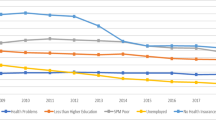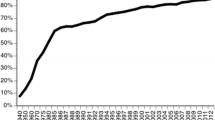Abstract
This paper measures racial inequalities in the US using a multidimensional ‘wellbeing’ approach that simultaneously considers the distributions of income, health and education. The primary objective is to examine trends in US wellbeing inequality with an emphasis on changes in racial composition. Data is taken from 1990 to 2007 and we observe increases in income inequality, a decline in education inequality and unchanged health inequality over the period. Taken together, these results show a slight increase in the dispersion in multidimensional wellbeing. Stratifying by racial groups shows that this increase is due to widening intra-racial inequalities while inter-racial differences remained unchanged. The method is also used to evaluate wellbeing across groups and we estimate black wellbeing to average around 76 % of whites, while persons from other races average approximately 93 %. Some other changes in composition occur through time and the results are shown to be robust to a number of changes in parametric weightings.
Similar content being viewed by others
Notes
While it may be possible to increase the number of indicators used to generate a more well-rounded measure, the more variables that are used, the more dependent the results become on certain aggregation assumptions. Thus the optimal way to proceed is to attempt to strike the right balance between parsimony and breadth of indicators.
While gender differences may be treated as fixed, the sharing of resources within households dilutes this inequality and complicates measurement issues.
These three indicators represent a fairly typical set e.g. see the recent work by Bossert et al. (2011).
Census data on median family incomes for racial groups can be found at http://www.census.gov/compendia/statab/2011/tables/11s0696.pdf.
In principle β could vary among attributes, reflecting different degrees of flexibility in substituting one attribute for another within a given index. This is left for future work.
For example 8.6 % of observations hit the educational top-code of 17 years in 2007 while only 6.9 % of observations reached this value in 1990.
The assessment of trends in perceived health is valid provided that (i) the subjective scores are appropriate indicators of true health status, and (ii) the self assessments are consistent across both time and across the racial groups.
Persons of Latino origin are classified as white.
The racial group ‘Other’ reports a higher average income than whites for 1991 and 1994. In all other instances whites outscore this group over all three criteria.
It should be noted that combining univariate inequality measurements is not a true ‘multidimensional’ technique as it misses the interaction that occurs between dimensions.
The time series available is too short to distinguish between stochastic and deterministic trends with the use of unit root tests and hence the regressions are conducted to identify significant movements within the sample rather than to describe the data-generating process. For this reason we also ignore potential autocorrelation issues.
Two sided p-vales are quoted in parentheses for a hypothesis test on the significance of the trend coefficient.
An impression of the changes in overall wellbeing over time can be gained by examining the racial means for each variable in Table 1.
Here the subscripts on the p-values refer to the parametric weighting specification employed.
Parameter estimates for the time trend coefficient (λ1) for the regressions w t = λ1+λ1 t + e t are (1) 0.000801, (2) 0.00107, (3) 0.000715 and 0.000997 for the four specifications. Dividing the gaps between white and black wellbeing at 2007 levels by these estimates yields estimated times to convergence of (1) 286 years, (2) 234 years, (3) 358 years and (4) 271 years.
References
Albert, C., & Davia, M. (2005). Education, wages and job satisfaction. Paper presented at EPUNET conference, Colchester.
Atkinson, A. (1970). On the measurement of inequality. Journal of Economic Theory, 2, 244–263.
Atkinson, A., & Bourguignon, F. (1982). The comparison of multi-dimensional distributions of economic status. Review of Economic Studies, 12, 183–201.
Atkinson, A., & Bourguignon, F. (1987). Income distribution and differences in needs. In G. R. Feiwel (Ed.), Arrow and the foundation of the theory of economic policy. London: Macmillan.
Bargain, O., Dolls, M., Immervol, H., Neumann, D., Peichl, A., Pestel, N., & Siegloch, S. (2011). Tax policy and income inequality in the U.S., 1978–2009: A decomposition approach. IZA discussion paper no. 5910.
Bertera, E. (2005). Mental health in U.S. adults: The role of positive social support and social negativity in personal relationships. Journal of Social and Personal Relationships, 22(1), 33–48.
Bossert, W., D’Ambrosio, C., & La Ferrara, E. (2011). A generalized index of fractionalization. Economica, 78(312), 723–750.
Brandolini, A. (2008). On applying synthetic indices of multidimensional well-being: Health and income inequalities in selected EU countries. Temi di discussione (Economic working papers) 668, Bank of Italy, Economic Research and International Relations Area.
Cowell, F., & Kuga, K. (1981). Inequality measurement: An axiomatic approach. European Economic Review, 15, 287–305.
Crimmins, E., & Saito, Y. (2001). Trends in health life expectancy in the United States, 1970–1990: Gender, racial, and educational differences. Social Science and Medicine, 52, 1629–1641.
D’Ambrosio, C., & Wolff, E. (2006). The distribution of wealth in the United States from 1983 to 2004: Inequality and polarization. In E. Wolff (Eds.), International perspectives on household wealth (pp. 394–440). London: Edward Elgar Publishing Ltd.
Darity, W., & Myers, S. (1998). Persistent disparity: Race and economic inequality in the United States since 1945. Cheltenham, UK: Edward Elgar.
Decancq, K., & Lugo, M. (2012). Setting weights in multidimensional indices of well-being and deprivation. Econometric Reviews, 32(1), 7–34.
Duclos, J., Sahn, D., & Younger, S. (2011). Partial multidimensional inequality orderings. Journal of Public Economics, 95, 225–238.
Feenberg, D., & Coutts, E. (1993). An introduction to the TAXSIM model. Journal of Policy Analysis and Management, 12(1), 189–194.
Foster, J. (1983). An axiomatic characterization of the Theil measure of income inequality. Journal of Economic Theory, 31, 105–121.
Gradin, C. (2010). Race and income distribution: Evidence from the US, Brazil and South Africa. Working papers 179, ECINEQ, society for the study of economic inequality.
Hoover, G., & Yaya, M. (2011). Racial/ethnic income inequality responses to a government maintenance program in the US. Public Finance Review, 39, 462–478.
Jones, S. (Ed.). (2008). The state of black America 2008: The black women’s voice executive summary. New York: National Urban League.
Jones, S. (Ed.). (2010). The state of black America 2010: Responding to the jobs crisis executive summary. New York: National Urban League.
Justino, P. (2005). Empirical applications of multidimensional inequality analysis. Poverty Research Unit at Sussex, Department of Economics.
Justino, P. (2012). Multidimensional welfare distributions: Empirical applications to household panel data from Vietnam. Applied economics. doi:10.1080/00036846.2011.577014.
Kao, G., & Thompson, J. (2003). Racial and ethnic stratification in educational achievement and attainment. Annual Review of Sociology, 29, 417–442.
Kolm, S. (1977). Multi-dimensional egalitarianism. Quarterly Journal of Economics, 91, 1–13.
Krieger, N., Chen, J., Waterman, P., Rehkopf, D., & Subramanian, S. V. (2005). Painting a truer picture of US socioeconomic and racial/ethnic health inequalities: The public health disparities geocoding project. American Journal of Public Health, 95, 312–323.
List, C. (1999). Multidimensional inequality measurement: A proposal. Working paper in economics, Nuffield College, and Oxford.
Lugo, M. (2005). Comparing multidimensional indices of inequality: Methods and application. ECINEQ Working paper series 2005–14.
Maasoumi, E. (1986). The measurement and decomposition of multi-dimensional inequality. Econometrica, 54(4), 991–997.
Maasoumi, E., & Nicklesburg, G. (1988). Multivariate measures of well-being and an analysis of inequality in the Michigan data. Journal of Business & Economic Statistics, 6(3), 326–334.
Muller, C., & Trannoy. A. (2011a) Multidimensional inequality comparisons: A compensation perspective. Working Paper THEMA, University of Cergy-Pontoise, France.
Muller, C., & Trannoy, A. (2011). A dominance approach to the appraisal of the distribution of well-being across countries. Journal of Public Economics, 95, 239–246.
Nilsson, T. (2010). Health. Wealth and wisdom: Exploring multidimensional inequality in a developing country social indicators research, 95(2), 299–323.
Pigou, A. (1912). Wealth and welfare. London: Macmillan.
Theil, H. (1967). Economics and information theory. Amsterdam, North Holland.
Trannoy, A. (2005). Multidimensional egalitarianism and the dominance approach: A lost paradise. In F. Farina & E. Savaglio (Eds.), Inequality and economic integration (pp. 284–304). London: Routledge.
Weiss, M. (2008). Skill-biased technological change: Is there hope for the unskilled? Economics Letters, 100(3), 439–441.
Western, B., & Pettit, B. (2005). Black–white wage inequality, employment rates, and incarceration. American Journal of Sociology, 111(2), 553–578.
Weymark, J.(2006). The normative approach to the measurement of multidimensional inequality. In F. Farina & E. Savaglio (Eds.), Inequality and economic integration. London: Routledge.
Author information
Authors and Affiliations
Corresponding author
Rights and permissions
About this article
Cite this article
Rohde, N., Guest, R. Multidimensional Racial Inequality in the United States. Soc Indic Res 114, 591–605 (2013). https://doi.org/10.1007/s11205-012-0163-0
Accepted:
Published:
Issue Date:
DOI: https://doi.org/10.1007/s11205-012-0163-0




